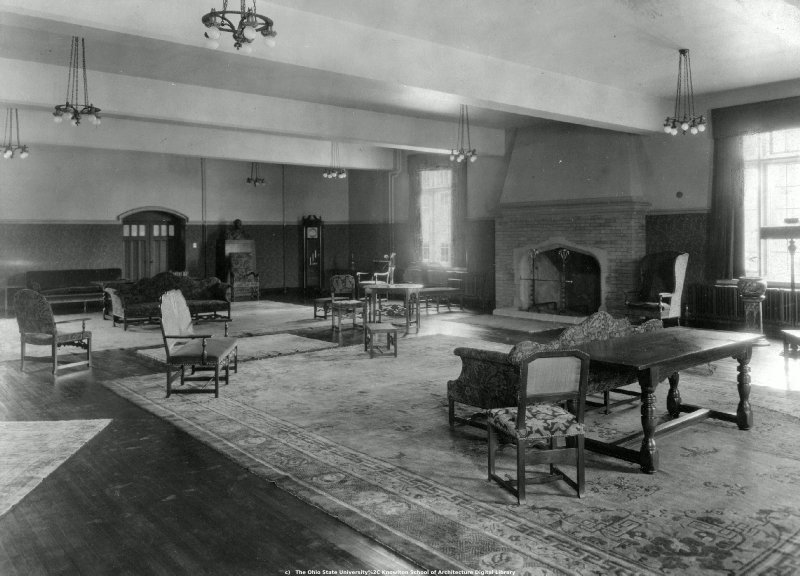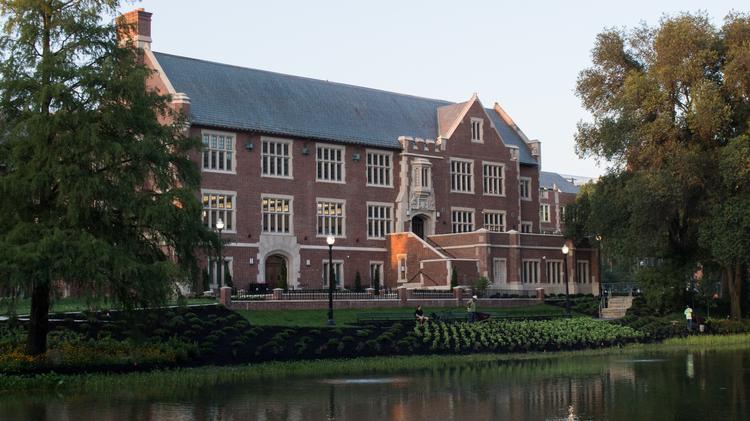The Browning Amphitheatre
The Browning Dramatic Society (associated with the Browning Literary Society), an all-girls group dedicated to performing the works of Shakespeare, was responsible for the founding of the amphitheatre on June 11, 1926. The first play to be performed in the Grecian-style amphitheatre was A Midsummer Night’s Dream. However, its use dwindled after the Browning Literary Society dissolved, and the site – still only a grass stage with tiered seating – eventually served only as study space for students. In 1985, Ohio Staters, Inc. financed the renovations to transform the space into a fully functional outdoor performance center, adding a concrete stage, electric lighting and dressing rooms (credit: Buckeye Stroll).
The 93-year-old historic Amphitheatre is located within the itself-historic Mirror Lake Hollow, an old, shallow rivine modified into an open-ended bowl shape by nearly one and a half centuries of erosion and development. The rivine once housed a stream, which was eventually diverted underground, and a pair of natural springs. Development of the area widened the areas surrounding the stream, often known as Neil Run, into a small lake consisting of several bog-like arms, which grew over time. An extraordinary paper on the history of the lake exists, written by none other than John H. Herrick himself, Executive Director Emeritus of Campus Planning and namesake of John H. Herrick Drive, which approaches the hollow from the west.
Originally, Mirror Lake was a collection of bogs that were fed by an underground stream known as Neil Run. Formal development of Mirror Lake occurred in the 1890s when a philanthropist offered to build an observatory on campus if OSU would build beautiful landscape around it. This probably saved Mirror Lake from having a road built through it. At that time Mirror Lake developed a more formal and cohesive look. The water in Mirror Lake tasted so good that people drank from it at the turn of the 20th century. The university even built a grotto for people to visit and drink the spring water. Over time, the spring dried up from all of the construction on campus and along High Street. Olentangy River water was used until 1972 when it became City of Columbus water. Mirror Lake has always been a place for student activities. One example was the Tug of War, between the freshmen and sophomore classes, which took place over Mirror Lake. Student organizations have used the Lake for ceremonies and hazing freshmen who did not wear their beanies (freshmen caps) or were found on the Long Walk of the Oval. In the late 1990s students began jumping into Mirror Lake before the football game against the University of Michigan (although students are strongly discouraged from going into the Lake) (credit: Buckeye Stroll). From November 2016 to August 2018, the lake was heavily renovated.
The wedding party will prepare inside the recently-renovated 92-year-old historic Pomerene Hall, along the rim of the Hollow. Designed by architecture professor Howard Dwight Smith, Pomerene was built in two phases. The 1922 section contained a gymnasium, where women's physical education classes were held, and social rooms. A second phase in 1927 added a natatorium, lounges, a kitchen and refectory. The Dean of Women's offices also were housed there, as were lounges, meeting rooms and a food-service unit called the Refectory. The building was named after Frank Pomerene, an 1891 graduate and one-time member of the Board of Trustees. The Refectory's first home had been in Campbell Hall, but it was moved to Pomerene when the second building opened. In addition to serving food, the eatery served as a laboratory for students in the Institutional Management Division of the School of Home Economics. Agnes Skinner Smith managed the Refectory for more than 40 years, until she retired in 1968. Following the construction of the Ohio Union in 1951, Pomerene Hall lost most of its original functions and purpose, although many of the women's physical education classes were held there until the late 1970s when an addition to the Larkins recreation center was built, allowing for more men's and women's locker room space. Over the years, the building has housed various University programs and offices, including the School of Physical Activity and Educational Services. That department moved in 2006 to the then-new RPAC building. In October 2011, the state Controlling Board approved $642,542 worth of renovations to the building, including work on faculty and staff office spaces, the Huntington Archive, and Visual Resource Library. In Spring 2012, the Department of History of Art made the second and third floors its new home (credit: Buckeye Stroll). From May 2017 to August 2018, Pomerene was expanded and renovated.

















































